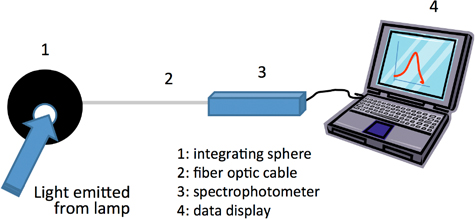The equipment consists of a spectrometer connected to an integrating sphere via a fiber optic cable. The integrating sphere scatters the light when the light source is pointed at an opening in the sphere. The light is collected and transmitted through the fiber optic cable to the spectrometer. A spectrometer is an instrument that registers the energy of the light at each wavelength by creation of a spectrum over an array of photodiodes.

The spectrometer has a CCD detector (linear array, 2048 pixels) and is USB-powered. These features ensures rapid sample speed (milliseconds) and data handling (milliseconds –minutes). Our system is configured for spectral irradiance measurements in the wavelength range 350-880 nm, but the software also provides other radiometric quantities, as well as photometric and colourimetric quantities based on plug-in applications.
The 15 centimeter diameter integrating sphere ensures all radiation emission to be collected inside. Generally, using a sphere will decrease positioning error. This particular sphere size is less sensitive to positioning of the LED than many smaller spheres sizes. More than 98% of the light in the specified wavelength range is reflected inside the PTFE-covered sphere, and a baffle prevents light from escaping from it.
The values obtained with this equipment were well within the measurement error range of the double monochromator spectrometer with which the lamps were previously characterised.
The equipment calibration is traceable to National Institute of Standards and Technology (www.nist.gov) and, through collaboration with the Optics Laboratory at the NRPA (www.nrpa.no), to other calibration institutions (www.ptb.de ; www.pmodwrc.ch ).
